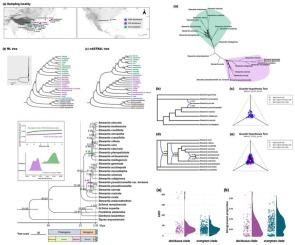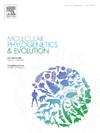杂交和不完全谱系分选是两个东亚茶属分支的进化历史特征。
IF 3.6
1区 生物学
Q2 BIOCHEMISTRY & MOLECULAR BIOLOGY
引用次数: 0
摘要
在东亚常绿阔叶林(EA-EBLFs)中,网状进化和顽固性系统发育关系是常见的。在这些森林中,杂交和不完全谱系分选(ILS)都可能在多样化过程中发生,但不完全谱系分选的程度往往被忽视。东亚-北美东部地区的植物属(EA-ENA disjuncts)是研究东亚-北美东部地区植物杂交和ILS程度的一个很好的系统。本文利用从被子植物(Angiosperms353)中获得的靶富集序列数据,研究了茶属植物(Stewartia L., Theaceae)的进化历史。茶属植物是EA-ENA分离科植物之一,其主要成员位于EA- eblfs中(EA约20种,ENA约2种)。通过几乎完整的分类群取样,我们在EA- eblf中恢复了两个Stewartia分支(EA落叶分支和常绿分支)。结果表明,这两个进化支在中新世晚期开始多样化,常绿进化支的多样化率高于落叶进化支。SNaQ和NANUQ分析在两个分支中检测到杂交信号,主要涉及S. serrata和S. tonkinensis。此外,QuIBL分析显示,在98/105和318/360测试的三胞胎中,基因渗入和ILS共同发生(Δ BIC本文章由计算机程序翻译,如有差异,请以英文原文为准。

Hybridization and incomplete lineage sorting characterize the evolutionary history of two East Asian clades of Stewartia (Theaceae)
Reticulate evolution and recalcitrant phylogenetic relationships are common in the East Asian evergreen broad-leaved forests (EA-EBLFs),. Hybridization and incomplete lineage sorting (ILS) can both occur during diversification of these forests, yet the extent of ILS has often been overlooked. Among floristic elements in the EA-EBLFs, plant genera that are disjunctly distributed between eastern Asia and eastern North America (EA-ENA disjuncts) provide an excellent system to explore the magnitude of hybridization and ILS after vicariance and long-distance dispersal. Here, we investigated the evolutionary history of Stewartia L. (Theaceae), one of the EA-ENA disjuncts whose major members inhabit the EA-EBLFs (ca. 20 spp. in EA vs. two spp. in ENA) using target enrichment sequence data obtained from Angiosperms353. Based on nearly complete taxon sampling, we recovered two Stewartia clades (the EA deciduous and evergreen clades) in the EA-EBLFs. Our estimates indicate that these two clades started to diversify in the late Miocene, and the evergreen clade showed a higher diversification rate than the deciduous clade. The SNaQ and NANUQ analyses detected hybridization signals within both clades, primarily involving S. serrata and S. tonkinensis, respectively. In addition, the QuIBL analysis revealed co-occurring introgression and ILS in 98/105 and 318/360 tested triplets (Δ BIC < − 10) in the deciduous and evergreen clades, respectively. The Phytop analysis further supported ILS as the primary source of gene-tree discordance. Our study reveals complex phylogenetic and evolutionary patterns in EA-EBLF endemics and highlights the importance of hybridization and ILS in this region.
求助全文
通过发布文献求助,成功后即可免费获取论文全文。
去求助
来源期刊
CiteScore
7.50
自引率
7.30%
发文量
249
审稿时长
7.5 months
期刊介绍:
Molecular Phylogenetics and Evolution is dedicated to bringing Darwin''s dream within grasp - to "have fairly true genealogical trees of each great kingdom of Nature." The journal provides a forum for molecular studies that advance our understanding of phylogeny and evolution, further the development of phylogenetically more accurate taxonomic classifications, and ultimately bring a unified classification for all the ramifying lines of life. Phylogeographic studies will be considered for publication if they offer EXCEPTIONAL theoretical or empirical advances.

 求助内容:
求助内容: 应助结果提醒方式:
应助结果提醒方式:


